|
115. Brenthis ino (Rottemburg, 1775) / Lesser marbled fritillary / Nymphalidae –Heliconiinae
NL: spireaparelmoervlinder, purperstreepparelmoervlinder / D: Violetter Silberfalter, ädesüss-Perlmutterfalter / F: grande violette, nacre de la sangsorbe
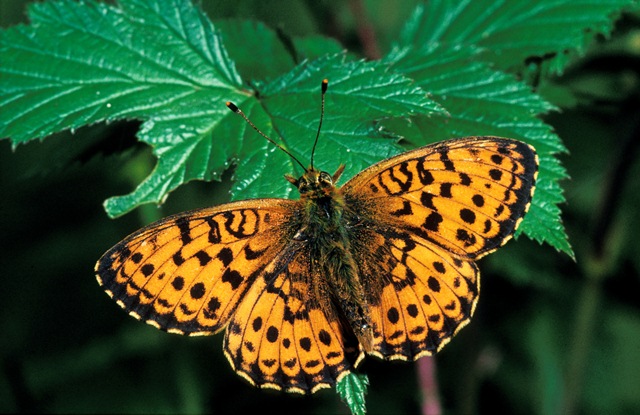 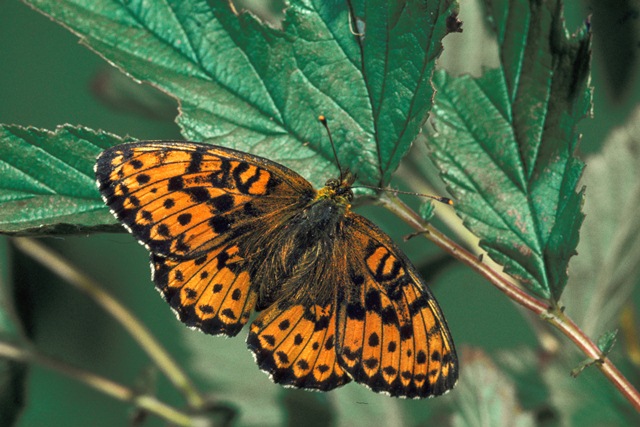 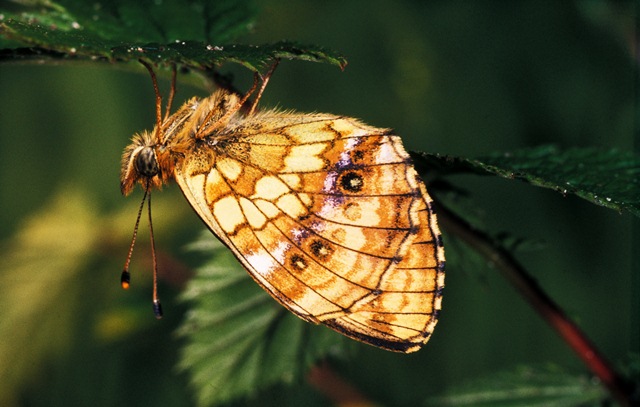
Photographs: Frits Bink ©.
Small or medium-sized, wing length 20 (17-22) mm. In the Benelux the species occurs in Luxemburg and Wallonia in marshes, along brooks and streams where meadow sweet (Filipendula ulmaria) grows. In the Netherland the species had disappeared by 1962; however, recently it has been observed in south Limburg (Bos et al. 2006: 306-307).
Butterfly is on the wing from mid-June until late-July. The species is known from sub-continental to severe continental climates, amplitude 8-20. Required heat sum 400°d, maximum tolerated 1500°d, corresponding climate windows 19 and 33 weeks.
In the Benelux Brenthis ino inhabits cool and humid sites, whereas B. daphne inhabits warm and dry sites. In Scandinavia, B. ino inhabits also chalk grassland where in lives on dropwort (Filipendula vulgaris) and also in raised bogs where cloud berry (Rubus chamaemorus) is the host-plant.
Ecological characteristics
Behaviour over time
Overwintering: egg on wilted flowers or leaves in the litter layer (the larva is fully developed within the egg shell after 19 days).
Reproduction: oviposition starts after 4-7 days when the body contains 45 (32-62) eggs, estimated potential production 2.7 times as much.
Larval feeding periods: 56 (51-60) days in the period of early-April until early-June.
Generations: one.
Spreading of risk: not observed.
Life cycle: egg 39-43 weeks; larva 8 weeks; pupa 15 (10-18) days.
Life span of adult: short, 2 weeks.
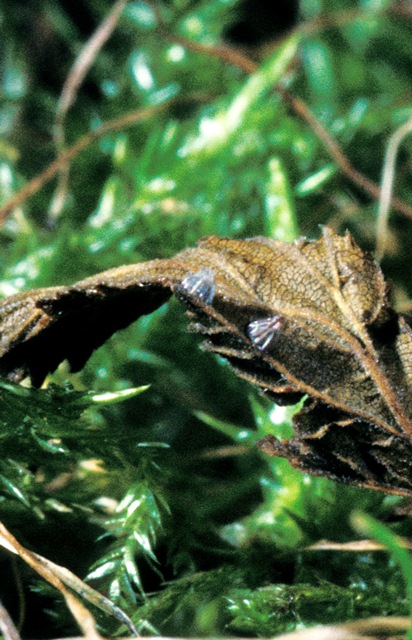 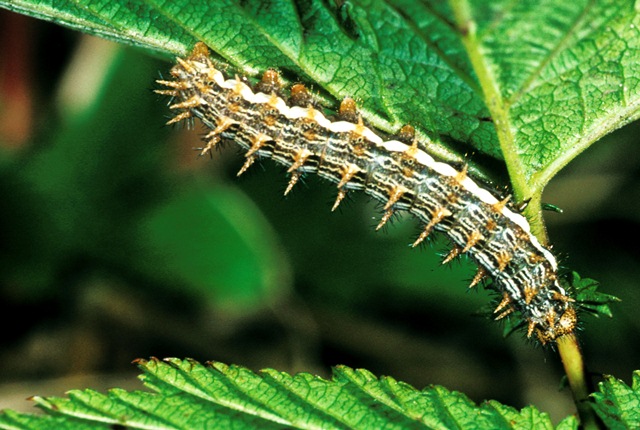
Photographs: Frits Bink ©.
Behaviour in space
From stay-at-home to migrant: stay-at-home, spatial requirements modest.
Finding a mate: male patrols and also congregates with females on flowers of the host-plant.
Orientation in the landscape: between river or stream banks and tall herb vegetation.
Oviposition: individually on old flower heads or leaves of the host-plant.
Defence
Threats from other organisms: the larva is armoured by spines and the pupa has golden spots, probably features to warn-off avian predators.
Threats from the environment: vulnerable, in the Ardennes the species is limited to cool and humid places.
Feeding habits
Adult: nectar of flowers.
Larva: newly hatched larvae accept only very young shoots, later they eat also mature leaves. The larva basks on dry, wilted leaves and search nearby plants for food, an example of homing.
Larval foodplants
Plant species: Rosaceae, Filipendula ulmaria, F. vulgaris.
Journal
Rearing experiments based on specimens from Ethe, Belgium:
11 July 1984: eight females captured.
14 July: first eggs laid.
18 July: 96 eggs laid by three females.
13 August: larvae developed in the egg shell and were free within the shell. Eggs repeatedly sprayed.
1 November 84: about 10% of the eggs were already dried out, about 20% looked healthy.
Overwintered outdoors.
8 March 1985: eggs taken indoors.
24 March: no activity.
5 April: not a single egg hatched.
Larvae collected from same locality:
23 May 1985: three larvae in fifth instar, one in fourth. The larvae fed during the day and at night.
27 May: first larva pupated.
29 May: second larva pupated.
6 June: first adult appeared, male.
12 June: second one, male.
Table 115-1. Results of dissections

Table 115-2. Collection and observation localities
B, Ethe, 240 m, 49° 36’ 25”N – 5° 35’ 50”E; 19 June 1983, 23 May 1984 (larvae), 11 July 1984.
B, Virton, 230 m, 49° 35’ 05”N – 5° 33’ 19”E; 20 June 1983.
D, Lorch, 300m, 50° 02’ 05”N – 7° 47’ 56”E; 14 June 1985.
F, Vosges, Sewen, 47° 48’ 26”N – 6° 54’ 48”E; 26 July 1983.
EST, Viruna, 58° 28’ 51”N – 23° 58’ 32”E; 5 July 1999.
EST, Endla Nature Reserve, 58° 52 34”N – 26° 16’21”E; 10 July 1999.
EST, Pööravere, 58° 40’ 25”N – 24° 36’ 50”E; 16 July 1999.
S, Gotland, Buttle, 57° 25’ 09”N 18° 34’ 38”E; 16 July 2004.
S, Gotland, Grogarns, 57° 25’ 32”N – 18° 53’ 21”E; 14 July 2004.
S, Gotland, Kappelshamn, 57° 55’ 04”N – 18° 45’ 20”E; 30 June 2004.
S. Gotland, Klinteklinten, 57 40’ 14”N – 18 46’ 26”E; 13 July 2004.
S, Gotland, Lickershamn, 57° 50’ 17”N – 18° 34’ 54”E; 3 July 2004.
S, Gotland, Lickershamn, 57° 51’ 05”N – 18° 37’ 46”E; 17 July 2004.
S, Gotland, Russväter, 57° 23 29”N – 18° 43’ 36”E; 16 July 2004.
S, Öland, Stenåsa, 56° 32’ 44”N – 16° 36’ 43”E; 7 July 1982, 21 July 2004.
Fig. 115-1. Brenthis ino, phenogram adapted from Fichefet et al. 2008: 139.
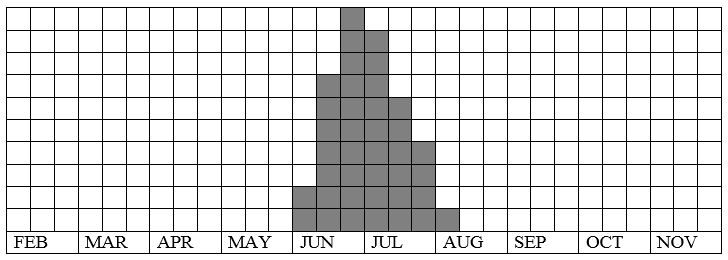
Fig. 115-2. Brenthis ino, habitat characteristics.
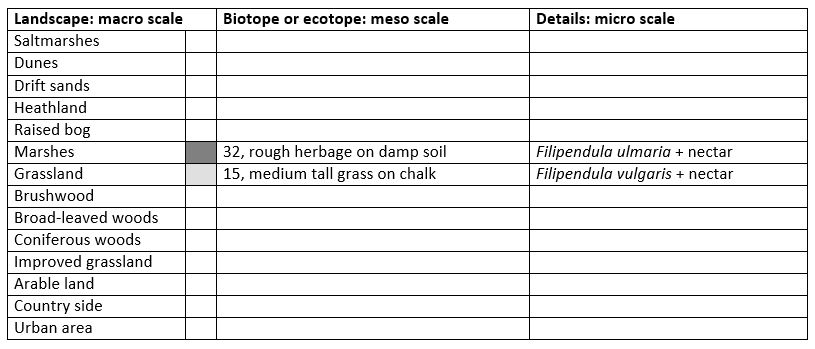
Fig. 115-3. Brenthis ino, climate matrix, heat-sums 400 - 1500°d.
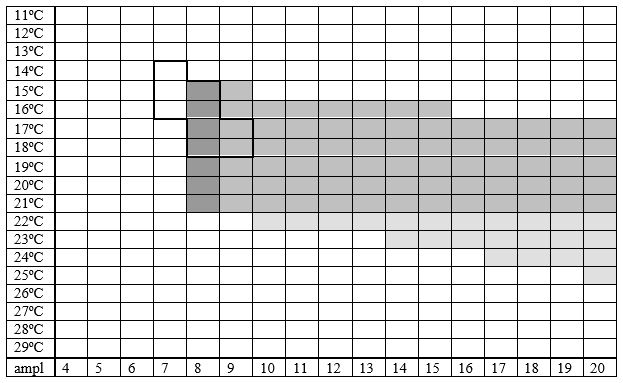
|










